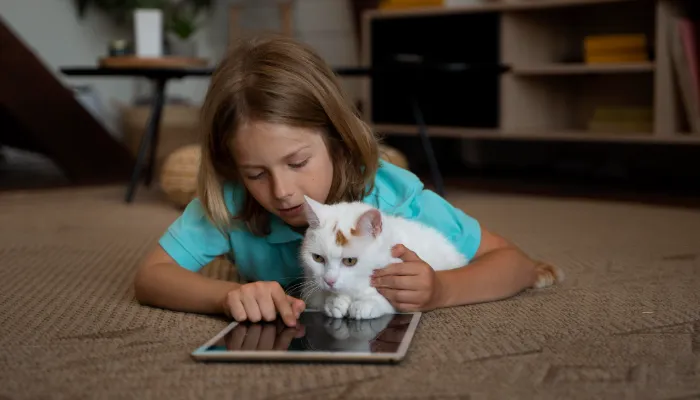Grasping feline communication is, at the same time, enjoyable yet challenging because you may not know what your cat is trying to tell you. An example of this is “How do cats say “No” in a straight forward simple way “ which a lot of pet owners ask themselves when a cat ignores commands, disobeys basic instructions, or gets annoyed.
In this blog post, we’ll focus on the different ways cats show discontent, and we will even apply a little bit of the cat translator strategy.

Body Language: The Silent Signals
While cats do talk, a majority of the communication is through body movements. They may not put it into words, but “How do cats say “No” is one clear example. A cat that is saying “no” can exhibit any of the following signs. So let’s take a look at which says “no”:
- Tail Flicking or Twitching: A cat’s, like most creatures, mood can be gauged from the tail. A flicking and twitching cat’s tail is likely showing annoyance and anger. If they do this, then they are clearly unhappy with the situation.
- Ears Back: When a cat feels threatened, scared, or agitated, they often flatten their ears. If your cat has its ears pinned back, then it is clear that they do not wish to participate in whatever activities you are doing.
- Stiffened Posture: A cat that suddenly stiffens its body, especially when someone comes close, is showing reluctance. The animal’s body becomes rigid as a way to communicate ‘I’m not okay with this.’
- Hissing or Growling: Cats will growl or hiss when they want to express extreme displeasure. This is a clear form of communicating ‘no’ to the upsetting stimulus.
Cats can communicate with humans and other cats in different ways, including boundaries, without using any words. As a “Cat Translator,” observing these signs is important so that conflicted situations can be avoided.
Vocal Cues: Meowing and Beyond
Cats are inherently silent creatures, but when they decide to vocalize, they do so in an individualistic manner. Let’s look at how do cats say “No” through sound:
Common Vocal Signals of Disapproval:
- Short, Sharp Meows: When a cat produces short, loud, and high-pitched meows, this suggests that they are annoyed and might also mean that they want you to stop doing whatever you’re doing.
- Growls and Hisses: While these are more aggressive ways of presenting disapproval, they tend to work as the more direct route when it comes to expressing disagreement. A combination of growling and hissing can mean back off and is usually verbal cue to pushy people.
- Chirps or Chatter: While this is one of the more common cat sounds, it’s mostly utilized for hunting. However, some cats may find themselves doing this if they are positioned in front of a window and spot something they want, like a bird that’s out of reach.
Cats tend to have different methods for expressing displeasure, so “how do cats say “No” can vary from owner to owner. But with the “cat whisperer” strategy, one can start noticing the specific noises a cat makes that reveal anger or discontent.
Physical Responses: The Paw of Disagreement
Some cats might opt to show physical discontent instead of directly expressing it through words. The following are some signs that you can look out for:
- Shooting: Shooting is a form of aggression exhibited by cats when they want to fend off something undesirable to them. Unwanted hands, toys, or pets are usually targets. A cat swatting at you means that they don’t want any engagement and want you to back off.
- Biting or Scratching: To exhibit boundaries, cats bite and scratch whenever they feel like they are nearing their breaking point during an interaction.
Cats can be very non-verbal and highly expressive with their paws in different situations. Be careful and attentive so that you can recognize the various signals and understand when your cat protests.
Avoiding Physical Interaction
Not all cats accept physical contact such as petting or handling. Unwanted attention is to them clear evidence of their ‘no’ moments, and is a trigger for aggression.
Signs that a Cat Wants to Avoid Physical Contact:
In order to communicate that they do not wish to be touched, a cat will turn their body away from you. This is an unambiguous form of saying no without initiating a conflict.
If a cat jumps away from you when you try to reach out to pet them, they are basically telling you that they refuse to be handled. Boundaries from the side of the cat should also be respected.
A cat will sometimes jump away from you because they want to establish some personal distance. It’s extremely important for “Cat Translators” to tell whether a cat’s attitude towards them is positive or negative based on what they physically do with their body.
Conclusion
So, How do cats say “No”? Regardless of your focus on body movements, vocalizations, or anything in between, there exists an entire array of possibilities through which a cat can display disapproval. Cats often use tail flicks, rough meows, or gentle swipes of their paws in order to communicate their needs.
Using this knowledge helps avoid misunderstandings in the future, and helps people understand their feline friend’s emotions. After reading this, the next time someone asks, “How Do Cats Say No?” you will definitely be able to answer that.
